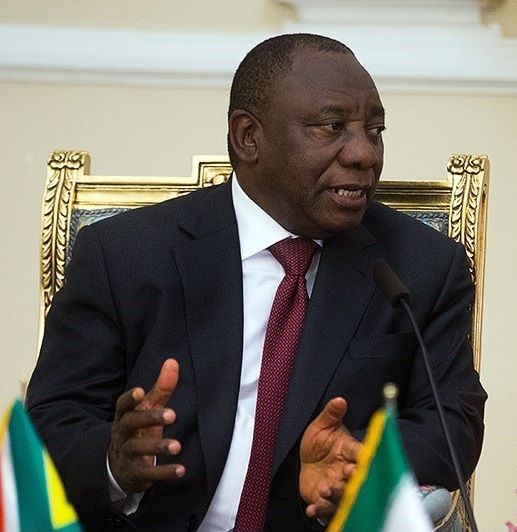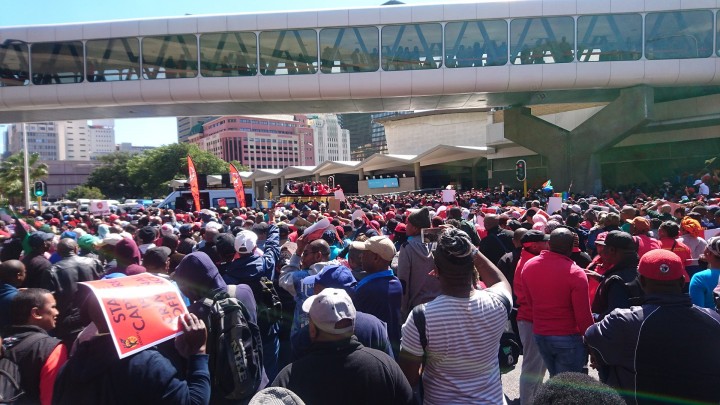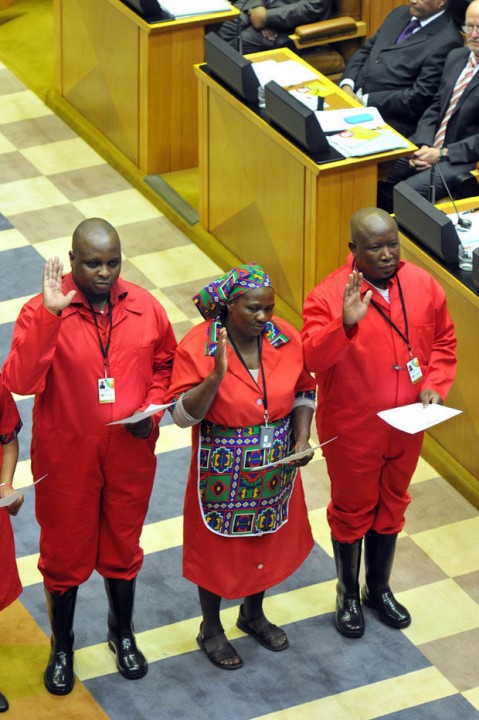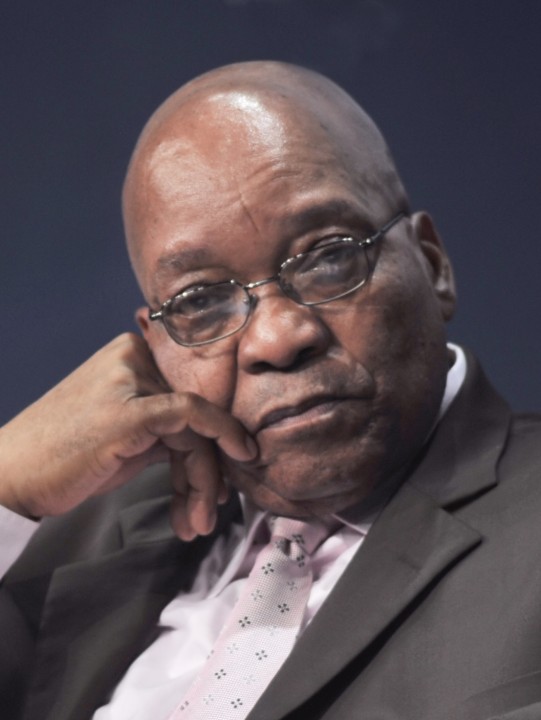Across the country, workers are mobilising for a mass general strike on 25 April. Although all sectors of the economy are likely to be affected, the strike is expected to hit municipal services, transport, manufacturing, mining, construction and the public sector particularly hard. The government’s determination to continue with the legislative process on proposed changes to the labour law is preparing the ground for a confrontation with the unions.
After four years of relative quiet on the industrial front the decision to forge ahead with the labour amendment bills currently before parliament could see the workers move back to the streets in full force to fight back against blatant attacks on their living standards and to protect basic trade union rights.
The right to strike
There are currently three bills before parliament. All three represent a direct attack on the working class. Two bills relate to amendments to the Labour Relations Act and the Basic Conditions of Employment Act and one bill is on the proposed national minimum wage. The Minimum Wage Bill, which will have the effect of legalising slave wages of 20 rand per hour, were supposed to become law on 1 May but due to the mass resistance, the government has suspended its implementation, claiming insufficient consultation. This is already a partial victory but the task is still to push ahead so the bill could be changed to carry the demands of the workers for a living wage. The dominant demand from the workers (arising from Marikana) is a wage of 12,500 rand.
Two of the other proposed changes to the labour law relate to the right to strike. One of the amendments would require unions to hold secret ballots when workers are deciding whether to strike or not. Again, this is a direct attack on trade unions. The strength of the workers their collective power. Individualising the strike through the introduction of secret ballots will undermine the inherent collective nature of strikes. It will give employers a pretext to intervene in the process on procedural and technical matters. For instance, a strike may not be ‘protected’ (lawful) if all members has not voted. This is a procedural matter the employers could use to interdict a strike even if a huge majority has voted in favour of it. This is a blatant attack on trade union democracy.
A second proposal is to amend the Labour Relations Act to introduce an advisory arbitration panel to decide on any strike. This mechanism could be requested by any employer and will give them a way to deal with the strike without negotiating with the union directly. The changes could also see strikes and pickets go through a commissioner who would determine picketing rules! Collectively these are some of the greatest attacks on South African workers since the days of the Apartheid regime.
Mass anger
These attacks come at the same time as the government is already implementing a brutal austerity budget, which on its own represents a frontal attack on the working class. These new measures, which have been implemented since 1 April, include a raise of 1 percent in Value Added Tax, the implementation of a sugar tax and an increase in the fuel levy. This is already a source of anger among workers.
Anyone who thought that Cyril Ramaphosa coming to power would change the course of South African politics is bound to be surprised. Ramaphosa is a billionaire businessman and he represents the traditional wing of the South African big bourgeoisie. His programme is to carry out the attacks on the working class that the Zuma administration could not, for various reasons. In the conditions a the deepening economic crisis, the South African capitalists can no longer afford the meagre concessions won by the workers over decades of struggle. To maintain its position, the ruling class is determined to attack the workers. Of course, the workers are not going to take this lying down.
 Cyril Ramaphosa is a representative of the traditional bourgeoisie. His programme is to carry out attacks on workers / Image: Erfan Kouchari
Cyril Ramaphosa is a representative of the traditional bourgeoisie. His programme is to carry out attacks on workers / Image: Erfan Kouchari
All of this is happening at the same time that the 50 biggest corporations alone are sitting on more than 1.4 trillion rand in cash, which they are not investing in the economy due to the crisis of overproduction. Instead of taking action against this blatant hoarding of cash by expropriating the rich, the government is taxing the poor! Additionally, the average pay for top executives in the top 100 companies has now reached an eye-watering 18 million rand! These are the same executives in Nedlac that are demanding that the unions should agree to lower wages for their workers. This shows whose class interests the government is serving.
To dig itself out of the economic hole that the ruling class has created, and in order to please the credit ratings agencies, the government is now putting the entire burden of the economic crisis on the shoulders of the workers, the poor, and the most vulnerable sections of society. This is fueling fresh anger among big sections of the working class.
The pressures from below have already forced trade union leaders to call for mass action. On 20 March, the radical mineworkers’ union AMCU, which came to prominence after the Marikana massacre in 2012, held a number of pickets and marches across the country to protest against job losses in the mining industry. AMCU is now the dominant union on the platinum belt and one of the fastest growing unions in the country.
Now the new labour federation, SAFTU, has announced that it will embark on a general strike on 25 April. This will be the first full-blown general strike by the federation since it was formed almost exactly one year ago. It has also made a direct appeal to the the rank-and-file workers of other federations, COSATU and Fedusa, to support the strike. The leadership of these two federations has been collaborating in the Nedlac “social partnership” forum with the government. The capitalists and have agreed to the bill on the minimum wage behind the backs of the workers and they have also put very mild resistance (in words) against the attack on the right to strike.
 SAFTU has made a direct appeal to the the rank-and-file workers of South Africa’s largest trade union federation, COSATU, to support the general strike / Image: Discott
SAFTU has made a direct appeal to the the rank-and-file workers of South Africa’s largest trade union federation, COSATU, to support the general strike / Image: Discott
SAFTU is South Africa’s second largest union federation after COSATU, representing 30 unions, including the National Union of Metalworkers of South Africa. It was launched in April 2017 and represents over 800,000 workers.
Already workers of the federation are staging a series of activities in the buildup to the general strike. On 12 April workers in the Western Cape marched on parliament in Cape Town. The mood was very radical with speakers threatening to make the country “ungovernable” if the government pushes ahead with the counter-reforms. General secretary of SAFTU, Vavi received a huge cheer when he rejected the proposed minimum wage and took aim at president Ramaphosa: “We are saying to Cyril Ramaphosa, take that 20 rand … you can find a space behind the beds of your buffalos and you can put that 20 rand there!”
Western Cape SAFTU deputy chairperson Nyaniso Siyana promised the federation will be back on 25 April to receive an answer on the memorandum. “We will shut the economy of this country down so they can listen. This economy is built on our own sweat and blood.”
These words are a reflection of the pressures coming from below which are pushing the trade union leaders to take a more militant stance. Worker-activists are also embarking on flying pickets to mobilise for the strike.
SAFTU also took up local demands of Cape Town, particularly the management of the water crisis in the Western Cape. The federation rejected the use of water management devices, saying that they essentially “commodifying” water.
“We accept we are in a drought…however, the bad management of the resource has led to this crisis. The City was aware of the crisis way back in 2003 and failed to take adequate steps to ameliorate the effects of the drought,” SAFTU said.
A major confrontation
In the context of the mass anger among the workers, the general strike could usher in a period of heated class struggle which could even reverberate during next year’s elections This depends on the approach of the union after 25 April. SAFTU is a new federation and the call for a one-day general strike will allow it test its ability to bring out the workers in great numbers. It will also allow us to accurately measure the real mood of the workers and give the workers a sense of their collective power.
A one-day general strike can give the government a serious warning but by itself is not likely to force it to back down. To achieve this, a serious and sustained campaign is necessary. A strong lead from SAFTU has the potential to win over large sections of the working class and the middle class and could change the landscape in the trade union movement. This depends on the leadership. A decisive lead can fundamentally transform the whole situation. The new development comes at a time general mood of anger beneath the surface of South African society. The pressures of decades of frustration is building up. This pressure needs an outlet and will find it one way or the other.
However, if this is limited to a single day of action, or even a series of one-day strikes, it could lead to a demorialsation of the workers. It will be just an occasion where the workers could blow off some steam and then return to work the following day without achieving any of their demands. Such a scenario has the potential to cause a serious crisis in SAFTU. However in such a case the anger of the workers will flow to other outlets. In this context we could see a return to the wildcat strikes we saw in 2012.
From the political front to the industrial front
Between 2009 and 2013 there was a massive explosion of strikes that battered the political landscape. The ANC, which for decades was the political home of the masses, was thrown into turmoil. The rightward drift of the ANC leaders and their reluctance to break with the capitalist system put them in the opposite camp of the masses. The most glaring example of this was the Marikana massacre, where state forces murdered dozens of defenceless miners who were striking for better wages. Since then, the degeneration of the ANC has only picked up speed. The top echelons of the party has been completely dominated by big capitalists who control different sectors of the economy. In the eyes of the masses, the party has little resemblance with the mass force it was during the revolutionary overthrow of the Apartheid regime. On this basis, the movement began to fragment along class lines with big sections of the youth and layers of the advanced workers moving sharply to the left.
The two most prominent manifestations of this were the political developments in the ANC Youth League and the developments in the unions. The Youth League began to agitate for the nationalisation of mines at the time. This led to a confrontation between the pro-capitalist leaders of the ANC and the Youth League. It is out of this battle that the Economic Freedom Fighters were born after the expulsion of the youth leaders headed by Julius Malema. The other big manifestation of the upsurge in the class struggle was the split in the trade union movement. This led to NUMSA being expelled from COSATU. It was this expulsion which led to the formation the new federation, SAFTU.
 The EFF made skillful use of parliament to expose the corruption and looting of state resources under Jacob Zuma, but his expulsion put them in a weaker position / Image: Flickr, GovernmentZA
The EFF made skillful use of parliament to expose the corruption and looting of state resources under Jacob Zuma, but his expulsion put them in a weaker position / Image: Flickr, GovernmentZA
These developments had a big impact on the class struggle. After four years of brutal and bloody battles on the industrial front, workers moved over to the political plane. The EFF’s entrance into parliament in 2014 managed to galvanise some of the most radical layers around it, especially from the youth. The political arena, especially parliament, became a focal point for the masses.
The EFF made skillful use of parliament to expose the corruption and looting of state resources under Jacob Zuma. This had a big impact. Its militant rhetoric also had a big impact on the radicalisation of the youth. Their influence on the #FeesMustFall student movement is a clear example of this.
However. it is also true that it still had not made a significant impact on the organised working class. Part of the reason for this is the role which some trade union leaders who have kept a distance from the the party. But the biggest reason is that the EFF did not actively incorporate the clear, working-class demands of jobs, a living wage, decent housing, a ban on labour brokers, decent working conditions, an end to retrenchments and so on into their campaigns. The EFF has also not used its parliamentary profile to denounce these blatant attacks on the rights of workers.
By putting its sole focus on Zuma’s corruption, the party has essentially undermined its own position, as the bourgeoisie has removed Zuma from the head of the ANC. Of course, Zuma was a corrupt and rotten politician, but he was essentially not different from the rest of the capitalist political class. He represents the rotten capitalist system and as we can see today, removing him has not improved matters for the masses.
 Zuma was a corrupt and rotten politician, but he was essentially the same as the rest of the capitalist political class / Image: 2009 EFA
Zuma was a corrupt and rotten politician, but he was essentially the same as the rest of the capitalist political class / Image: 2009 EFA
The EFF has also put much emphasis on the land question. This is an important issue that reveals the limitations of capitalism in South Africa. Yet it is not a key question for the majority most people, in particular the working class, which is the only class that can lead South African society out of its impasse. Thus the EFF has not yet managed to win over significant layers of the working class, which still remains without a clear, organised, political expression.
NUMSA at one point did address this problem. In the organisation’s countless resolutions, the limitations of capitalism and the need for a mass revolutionary party are clearly stated. When the union first made the call for such a party it was received with great enthusiasm by workers across the country. But unfortunately there seems to be a dichotomy between words and deeds. Four years later there is still no sign of a party. NUMSA has subsequently held another congress where it formally adopted a resolution on the establishment of a workers’ party. This delay has placed big obstacles in the path of the workers’ movement.
As the establishment of the EFF showed at the time, the conditions are very favourable for such a party. Had NUMSA followed through, the political situation in the country could have been radically different. A workers’ party, backed by big unions such as NUMSA would immediately have challenged the ANC’s dominance on the political arena. Instead the mass anger is channelled through trade union activity, such as rallies and limited strikes, which are very good and important, but which do not address the real problem. NUMSA admits this itself, acknowledging the limitations of the capitalist system.
These shortcomings have placed obsticlases on the political field and caused disorientation amongst the masses. The revolutionary mood has to a certain degree ebbed from the highs of a few years ago. Had there been a genuine Marxist leadership the political situation could have been very different. Yet this ebb is not to be taken as a defeat.
The general strike is a sign of things to come. The anger that had been present among all layers of the working class between 2009 and 2013 never went away. During this time, the struggles of the workers changed things on the political landscape. Of course, after four years of continuous struggle, a certain weariness crept in. In the past period, the workers looked to parliament for signs of change, but with NUMSA eternally procrastinating and the EFF not giving a clear lead there has been a mood of confusion. This added to the general disorientation. But while there might be signs of slight fatigue, the working class is still very vibrant and confident. It has not lost a single major battle for decades. But now, under the impact of the increasing provocations and attacks by the ruling class, the class struggle is set to take off again.
